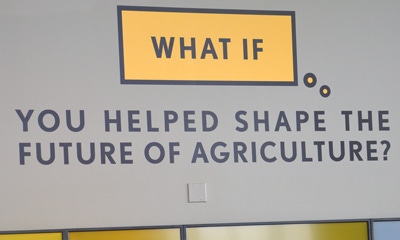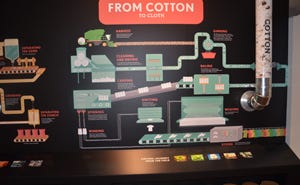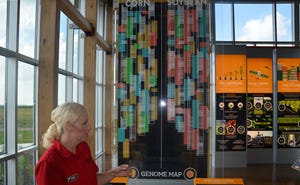
The Fair Oaks Farms Crop Adventure isn’t complete until you’ve traveled into the future, located just past the present in agriculture, which we visited yesterday. You will learn more than just what GMOs are, if you don’t already know. You will be introduced to plant genome mapping, and get a glimpse of what tomorrow might bring.
WinField, the major sponsor for The Crop Adventure, invested three years’ worth of planning and lots of ingenuity to put the exhibit together, notes Jamie Miller, attractions manager at Fair Oaks.
“Visitors can learn what farming was like in the past, what it is like today, and then get a feel for what it might be like tomorrow.”

STOP AND THINK: This thought-provoking display greets visitors just before they exit Fair Oaks Farms' WinField Crop Adventure. You can’t leave without thinking about your role in tomorrow after seeing it.
Here are the final six stops in your Crop Adventure tour.
Stop 1. Corn winds up in many uses today.
The goal behind this exhibit is to show how farmers feed billions of people now — and how they will be challenged to feed billions more in the future. Along the way, the crops farmers grow are also processed into other things, such as corn being used to make ethanol for fuel.
Stop 2. Cotton is still an important player in agriculture.
Just because you don’t grow cotton doesn’t mean it isn’t an important part of agriculture today. Technology has reached cotton fields as well, with GMO-protected varieties to guard against insects, and varieties that can withstand various herbicide applications either here already or coming in the future to help control weeds.
Stop 3. Careers in agriculture spin out of technology today.

WHERE FIBER FITS IN AG: Don’t try to grow it here — it won’t mature. But cotton for fiber and cotton byproducts for animal feed are still important to agriculture’s story.
Few people are telling agriculture’s story and discussing the great career opportunities available off the farm today, so farmers generally have to do it themselves. WinField gives farmers a boost by including a career display in the Crop Adventure exhibit.
Stop 4. Modern plant genome maps are common today.
Unheard of just a few years ago, genome maps now exist for various crops. Knowing the genome can help speed efforts in plant breeding, leading to developing higher-yielding crops more quickly.
Stop 5. Colorful diagrams simplify difficult topics.
Spend a few minutes checking out the GMO display and you should have a better grasp of what GMOs are, and why many consider it a breakthrough that scientists can insert genes with specific traits from a different organism to assist a corn or soybean plant.
Stop 6. A seed chipper is a tool of modern technology.
A real seed chipper was donated for display in the exhibit. It’s used to produce tiny chips of seed material that scientists can use in breeding programs to track DNA and other important information. Machines like this one have helped speed up the development process in the search for new biotech traits.


MODERN PHENOMENON: Even 10 years ago, this tour might not have included this plant genome display, but today it is part of moving agriculture forward, attractions manager Jamie Miller tells visitors.
BIOTECH TOOL: This seed chipper was actually used by a company to gather more genetic material quickly and speed up the search for improved varieties and newer traits.
About the Author(s)
You May Also Like




